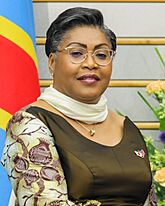Prime Minister of the Democratic Republic of the Congo facts for kids
Quick facts for kids Prime Minister of theDemocratic Republic of the Congo |
|
|---|---|

Arms of the Democratic Republic of the Congo
|
|
| Appointer | Félix Tshisekedi, as President of the Democratic Republic of the Congo |
| Inaugural holder | Patrice Lumumba |
| Formation | 24 June 1960 |
| Website | www.primature.cd |
The prime minister of the Democratic Republic of the Congo is the head of government for the country. This means they lead the government and manage its daily activities. The official titles in other languages are French: Premier ministre de la République démocratique du Congo (French), Swahili: Waziri Mkuu wa Jamhuri ya Kidemokrasia ya Kongo (Swahili), and Lingala: Minisele ya Yambo wa Republiki ya Kɔ́ngɔ Demokratiki (Lingala).
The country's constitution gives the prime minister a lot of power. They work closely with the president to run the nation.
Currently, Judith Suminwa holds this important position. She became prime minister on 12 June 2024, taking over from Sama Lukonde. Judith Suminwa is a very important figure because she is the first woman to ever be prime minister of the Democratic Republic of the Congo.
Contents
History of the Prime Minister Role
The role of prime minister has been around since the Democratic Republic of the Congo became independent. The very first prime minister was Patrice Emery Lumumba, who took office in 1960.
Changes to the Prime Minister's Power
Over the years, the power of the prime minister has changed a lot. Sometimes, the position was very strong, and other times it was quite weak. There were even long periods when the role didn't exist at all.
For example, during the time of Mobutu Sese Seko, who was president for many years, the prime minister's job was abolished in 1966. Later, in 1977, Mobutu brought it back but called it "First State Commissioner." This new role had much less power than the original prime minister position. People in this role were appointed by Mobutu and didn't have much say. The position disappeared again when Mobutu left power in 1997.
Important Prime Ministers
Besides Patrice Lumumba, other important leaders have served as prime minister. One was Moise Tshombe, who had previously led a part of the country called Katanga when it tried to separate. Another key figure was Étienne Tshisekedi, who was a strong opponent of Mobutu's government for a long time. He became prime minister three times because people strongly supported him.
The Role Returns
The position of prime minister came back as an official part of the government with the new constitution, known as the "Third Republic." On 30 December 2006, Antoine Gizenga was appointed as the first prime minister under this new system. Gizenga was a unique choice because he was one of the few politicians still active who had been involved in the country's government way back in 1960. He had even been Lumumba's deputy prime minister and led a different government during a difficult time in 1961.
What the Prime Minister Does
Under the current constitution, the prime minister shares the job of leading the government with the president of the Democratic Republic of the Congo. The president chooses the prime minister. Usually, the person chosen comes from the political party or group that has the most members in the National Assembly (which is like the country's parliament).
Sharing Power with the President
The prime minister plays a very important role in the government. If the prime minister and the president are from the same political party, the president is usually seen as the main leader of the government.
However, sometimes the president and the prime minister are from different political parties. This situation is called "cohabitation." When this happens, the prime minister becomes even more important. This is because the president cannot make many big decisions without the prime minister's agreement. It means they have to work together closely, even if they are from different political groups.
Requirements for the Position
The constitution doesn't list specific rules about who can be prime minister. The most important step is that the National Assembly must approve the government's plan and the people chosen for the government. Once that happens, the government, led by the prime minister, can officially start its work.
See also
- Government of the Democratic Republic of the Congo
- President of the Democratic Republic of the Congo
- List of heads of state of the Democratic Republic of the Congo
Historical:
- Colonial Heads of Congo
- Rulers of Katanga
- Rulers of Kuba
- Rulers of Luba
- Rulers of Ruund (Luunda)
- Rulers of Kasongo Luunda (Yaka)
- Rulers of Kongo
- Zaire


